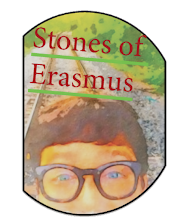I'm not sure how to square philosophy with literature. I don't mean to sound philosophical with this sort of statement. I mean: how do I square literature, as in literature in how it is studied in American academic departments, with philosophy in academia. Not thinking about the zillions of ways to do literary theory and the zillions of way to do philosophy. Rather, I'm caught betwixt and between, one foot placed in a literary world, and the other, placed in a philosophical world.
Novels do not seem on the face of it to be concerned with epistemology or questions of language. Yet, novelists love to pepper stories with philosophic allusions. Philosophers employ literary metaphor to suggest their specific points.
One may applaud me for being so interdisciplinary. Literary studies has for a long while been influenced by philosophic thought. Philosophy likes to think about the possibility of literature, or the conditions that make literary reality possible. Derrida is famous for pushing literature to the fore by asking again and again in numerous books and essays, "what the fuck is literary affect? What does it mean to have a literary effect? And how come literature's "affects" become articulated in philosophical musing?
In graduate study of English, I was immersed in theory. We did not discuss Derrida's questions. Not to say we didn't discuss Derrida. We just were not concerned with Derrida's questions. We were more concerned with deconstructing a text or psychoanalyzing a character. I learned to think through a novel's structure using clever theories. It was fun. My difficulty, however, was always trying to extract from a piece of literature a philosophic thought. Walker Percy's
The Moviegoer: I extract existentialism. William Shakespeare's
Midsummer Night's Dream: I extract the distinction between appearance and reality. Ralph Ellison's
Invisible Man: radical alterity. John Milton's
Paradise Lost: the ontology of evil. And so on.
In philosophy departments, the study of literature is reversed. It's not what can be extracted from a particular literary piece that is important, but questioning literary methodology itself. Philosophy makes philosophy from literary expression. What makes a novel feel? How is a poem a poem? Where is the moral good in literary fiction?
Philosophy sees itself as superior to literature. Literature sees itself as more beautiful than philosophy. No one asks if a philosopher is literary or not. And if they do, philosophers shrug their shoulders. So what if Plato, Kierkegaard, or Nietzsche are literary. That's cool, says the philosopher, but Kant is much clearer. So what if Milton's view of prelapsarian innocence is whack. Milton's poetry cannot be approximated. Philosophers get frustrated by literary tropes. Literature buffs become weary of theory. Give me a clear, well thought out argument, says the philosopher. Philosophy is preoccupied with meaning: what we say. Literature is preoccupied with suggesting what is not said.
I had a few fellow graduate students read a philosophy paper I wrote on whether a reclamation of history was possible in Kant's
Third Critique. "Relegate your literary allusions to the footnote," one of my colleagues wrote in the margin. I guess he's right. What does Homer have to do with Kant?
Kant, it seems to me, could learn much from Homer. Waywardness. For one. Homelessness. The comfortable homeliness of the categories (the moral law within!) can't tolerate raw homelessness.
Homer could learn a thing or two from Kant. I'm not sure what, though. Odysseus does not seem to be an exemplar of the categorical imperative. Who is an exemplar of the categorical imperative? Even Jesus Christ would have to be asked, "Yo, Jesus! Do you follow the moral law?"
Literature came late to philosophy. Plato expelled the poet from the city-state.
In a way, literature is still expelled from the city-state.
The philosopher asks about the novel, "is the novel dead?" The novelist asks, "Will they buy my book?"
I said earlier that my feet are squarely in both worlds. In English departments, we call philosophy "theory." Although not all theory is philosophy. Some theory is literary criticism. Although some literary criticism is philosophical, I'm not sure if philosophy could every be considered literary criticism. In philosophy departments, we call what we do analytic or continental. But, then, even those distinctions quickly get muddled. Literature is subsumed under aesthetics. But, aesthetics is a non-word in comparative literature. We just assume literature is beautiful. It's left to the philosopher to figure that one out. In literature, philosophy is the search for wisdom. We are not so sure what to do with Kant or Plato. We're happy enough to supply beauty without questioning it.
I will end my musing this way: I've arrived at a question about embarrassment. Why is it embarrassing for a philosopher to resort to fiction? For the novelist, there is no such embarrassment. In fact, if there is something philosophical
there he will grin. For the literary critic, it is not embarrassing to avoid philosophy altogether. In fact: in some circles, it is encouraged.
The beauty of philosophy is its ability to care about stuff the novel confronts willy-nilly. Heidegger's
Being and Time has no comparison in the literary canon. What I love about fiction is its unabashed embrace of play. There will never by a Vladimir Nabokov in the School of Athens. That is why: I have two books on my shelf: in the brain, I have my philosophers; in the heart: I have my literature; the rest I put up my arms in a certain
Je ne sais quoi.
image credit: cindy sherman


















